Olga de Amaral
Olga de Amaral (born 1932[1]) is a Colombian visual artist known for her large-scale abstract works made with fibers and covered in gold and/or silver leaf. Because of her ability to reconcile local concerns with international developments, de Amaral became one of the few artists from South America to become internationally known for her work in fiber during the 1960s and ‘70s.[2] She is also considered an important practitioner in the development of postwar Latin American Abstraction. She currently lives and works in Bogotá, Colombia.[3]
Olga de Amaral | |
|---|---|
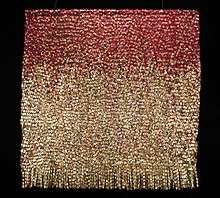 | |
| Born | Olga Ceballos Vélez 1932 |
| Nationality | Colombian |
| Education | Cranbrook Academy of Arts (1954-55) |
| Known for | tapestry, textile art, color, gesso, gold |
| Style | abstract art |
| Spouse(s) | Jim Amaral |
| Website | http://olgadeamaral.art |
Biography and education
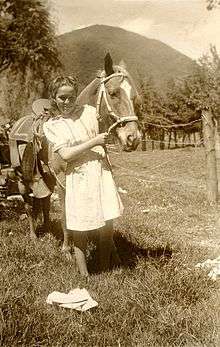
Olga de Amaral was born Olga Ceballos Velez in 1932 in Bogotá, Cundinamarca, Colombia, to parents from Colombia's Antioquia region.[4] She was raised in a traditional religious family with 5 sisters and 2 brothers. She grew up in a traditional neighbourhood in Bogotá in a warm, safe family atmosphere, maintaining a special relationship with her loving and caring mother. Upon graduating from high school, in the years 1951–52 she got a degree in Architectural Design at the Colegio Mayor de Cundinamarca in Bogotá.[4] After graduation, the future textile artist worked for a year as a director of the Architectural Drawing Faculty at the same school.
In 1954, de Amaral went to New York City to study English at Columbia University.[4] From 1954 to 1955, she studied fiber art at the Cranbrook Academy of Art in Bloomfield Hills, Michigan.[5] She stated about her time there as a student: "In Cranbrook, the textile workshop had eight looms placed against the windows: one of them, in the corner, would be my home for a year. There, I lived my most intimate moments of solitude; there was born my certainty about color; its strength; I felt as if I loved color as though it were something tangible. I also learned to speak in color. I remember with nostalgia that experience in which souls touched hands".[6] At Cranbrook, de Amaral met Jim Amaral and they became close friends.[5]
In 1955, after a year in Cranbrook, she returned to Colombia and started to make decorative textiles on commission for her architect friends. Meanwhile, Jim Amaral served in the U.S. Navy on a base in the Philippines.[5] In 1956, Jim Amaral visited Colombia to see Olga, initially for a few weeks. They married in 1957 and settled in Bogotá.[5] They had two children, Diego and Andrea, and started a workshop for handwoven textiles. During that period, Jack Lenor Larsen visited Colombia and the Amaral's workshop. He expressed interest in Olga's tapestries. Their professional and artistic relationship became crucial in projecting her work into the international world of contemporary tapestry. In 1965, de Amaral founded and taught at the Textile Department at the University of Los Andes (Colombia) in Bogotá.[7]
In 1966-1967 the Amaral family lived in New York.[4] There, Olga de Amaral met Eileen Vanderbilt from the World Crafts Council and became the Council's Colombian representative.[4] With Larsen's collaboration, Olga de Amaral displayed her tapestries in New York City (during a 1967 solo exhibition in Larsen's New York showroom), and taught at Penland School of Crafts in North Carolina and at Haystack Mountain School of Crafts in Maine. After returning to Colombia, the Amarals travelled to Popayán and Tierradentro region with its must-see San Agustín. Later Olga visited Peru as the WCC representative. On a rapid visit to Ireland to participate in a WCC conference, Olga met Lucie Rie, a British ceramist who inspired her to incorporate gold into the tapestries. At the beginning of the seventies, the Amarals moved to Barcelona and then to Paris. They visited Greece, Italy, the Netherlands, Belgium, Switzerland, Sweden, and England. They made contacts with the centres of European art. They lived for a time in Europe, then returned to Bogotá, visited different areas of Colombia, and then went back to France, amid exhibits, work, and new friendships. Another important journey for the artist was her travel to Japan.
Art
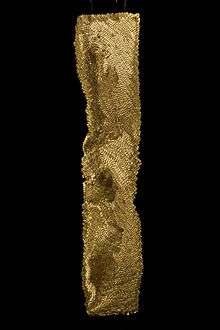

"I am not familiar with current tendencies in textile design. It seems to me that those who weave artistically base themselves only partially on fiber craft, which in my opinion, makes no sense. I consider that one must base oneself on precision, on mathematics, on color theory. What is woven, does not occur by chance, but totally the opposite - it is very calculated. I can't do that because I am not trained and because I am in the midst of an abstraction. Finally, my work is nothing more than my way of telling how I feel about life, about the soul of things." –Olga de Amaral[6]
From the beginning, Olga de Amaral's art has been driven by the creation of works that redefine our notions of unity, concept, representation, and personal expression. de Amaral explores and revisits ideas, techniques, and processes, looking for subtle and intricate variations within her own artistic process. She is an important figure among a globally dispersed group of artists who are deconstructing and rethinking the structure, surface, and support of painting by adding sculptural dimensions and atypical materials.[8] Her work takes the elements of painting off the stretcher and into space, approaching the problem of the superposition, of layering in a painting form the point of view of the material itself – the painting's support, the canvas, the fabric or texture.[9]
At first categorised as two dimensional, representational wall hangings, in the late 1960s her works entered the genres of sculpture, installation, abstract and conceptual art:
"De Amaral's art deftly bridges myriad craft traditions; it's concerned with process and materiality, with the principles of formalism, abstraction and metaphysicality. The artist has developed a distinct voice in her field through her command of conventional techniques for constructing textile objects while progressively pushing the boundaries of orthodox understanding of how textiles work as objects in space. She has gradually moved fabric-based works beyond the category of woven tapestry - one that privileges flatness, adherence to the wall, pictorials, and an obsession with the organic and the physical properties of materials - into a more conceptual practice that embraces strategies otherwise found in painting, sculpture, and architecture."[10]
The way the artist incorporates the materials, natural and man-made fibres, paint, gesso, and precious metals (gold and silver leaf mostly), through the handcraft, artisanal process and techniques, reference Colombia's pre-Hispanic art, indigenous weaving traditions, and the Spanish Colonial Baroque legacy, brought to the New World by the Catholic colonists.[11] As Twylene Moyer indicated, this inspiration is "a true mestizaje, or mixing of cultures."[12] What those cultures had in common, was that they all attributed great expressive power to the visual, just as de Amaral's work embody visual and tactile content "reconnecting us to an ancient understanding and appreciation of images as presences unto themselves, capable of transcending materiality to express truth through beauty".[12] This ability to connect the ancient and the contemporary[10] has allowed the artist to create works on the premise that "art has the power to transcend representation and embody spiritual and emotional values through form. (...) Her tapestries are nothing less than meditations on the illusive nature of meaning."[12]
Thread, color and light determine the visual and metaphorical aspect of de Amaral's works. "I began to work with fiber by coincidence - a sought coincidence - and have continued with it because it has never disappointed me. As I get to know it better, the better it knows me. In briefer words, it has never stopped arousing my curiosity. Fiber is like an old pencil: one has used it for so long that you take it for granted. I am made of fiber because I have embraced it and because I know it".[6] Olga de Amaral on color: "When I think about color, when I touch color, when I live color - the intimate exaltation of my being, my other self - I fly, I feel as another, there is always another being next to me."[6]
de Amaral's art is most often interpreted through the themes of architecture, mathematics, and socio-cultural dichotomies in Colombia, but mostly landscape: "Fascinated by the shapes of rocks, streams, hills, mountains, and clouds, she finds inspiration in the broken textures and movements of the landscapes surrounding her home in Bogotá. From the geometric designs of medieval cosmological diagrams to the grids of Mondrian, harmonious symmetry of form has alluded to and partaken of perfection and the absolute."[12] Her oeuvre is characterized by various series, each with a particular essence or technique that encompass a plethora of intricate variations developed throughout her career. The titles of de Amaral's numerous series reveal the themes behind her weavings: Alchemies, Moonbaskets, Lost Images, Ceremonial Cloths, Writings, Forests, Rivers, Mountains, Moons, Square Suns, Umbras, Stelae, etc. As Amparo Osorio pointed out, "much of poetry (...) emerges from these images in movement, whose titling (…) is another referent for us to achieve an understanding of this recondite sense, of that desire to say in the language of symbols all that is beyond words."[13]
Early work from the 1960s
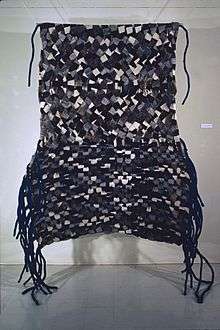
The early period of de Amaral's oeuvre is characterised by visually relatively traditional tapestries, but already presenting the search for an individual language through formal experimentations. Since the mid60s, she worked mostly with hand-spun wool, cotton, linen, and dyes. Vivid colors and bold combinations and the exploration of the structure and edges of weaving characterize some of her small scale early work of this period. The geometric conception and composition of these works reveal a profound awareness and understanding of the modern artistic tendencies of the time, bringing to mind the De Stijl abstraction current among others.

In 1966 the Amarals were invited by Miguel Arroyo to show their work at the Fine Arts Museum in Caracas, Venezuela. It was the first solo show by Olga de Amaral outside her native country. In 1967 Olga presented her work for the first time at the prominent Lausanne Biennale in Switzerland, the first out of six later appearances at that event. In 1969 Olga de Amaral took part in a collective exhibition of 27 fiber artists at MoMA New York entitled “Wall Hangings”.[14] It was an international exhibition curated by an architecture and design curator Mildred Constantine organised with Jack Lenor Larsen and presented not in the architecture and design lobby as usual for the fiber artists, but in the art section of MoMA, that up until then was reserved only for painting or sculpture. This was the importance of that exhibition - it addressed the transformations in the medium of fiber art, noted differences between the continents and anticipated the experimentation to come.[15]
In the late 60's, with the creation of the piece Entrelazado en naranja, gris, multicolor (1969), de Amaral eventually "exploded the picture plane from inside out".[9] At the end of this period, the artist left the fundamental concept of fabric weaving (the opposition between warp and weft), by leaving only the warp (in the form of braiding) and letting it float freely. The full form or volume stressed in the composition of the pieces from this period, make them look almost like thread sculptures. However, after this period of pushing the art of weaving to its boundaries, in the next decade, the issue of the flat surface will emerge again in de Amaral's art. Olga's massive hangings called Muros tejidos (Woven Walls), solid bulwarks built from stiff wool and horsehair, debuted at a solo exhibit at the Museum of Contemporary Crafts in New York in 1970.[2] In 1971 Olga took part in an exhibition "Deliberate Entanglements" at the University of California, Los Angeles organised by its art professor Bernard Kester. It showed American and Eastern European fiber art for the first time in Southern California. It reflected the era's revolutionary fiber sculpture, particularly its tendency towards monumentality.[15] "When I started to show my work in Europe and the USA, it was considered art, not crafts. And it was then that I realised that it was not the weaving, but the visual quality that now mattered in my creations."[16]
The shift from crafts to fine art in the 1970s
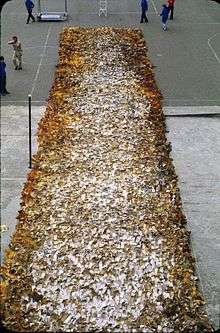
In the 1970s Olga de Amaral started the following series: Muros, Corazas, Hojarascas, Marañas, Estructuras, Fragmentos completos, the Calicanto series, Farallones and Eslabones. "From the beginning of her career in the 1960s, certainly from the Muros and Hojarascas of the 1970s, Amaral had made it clear that the debate over whether weaving was art or craft would be, in her case at least, moot. From the onset, there has been a distinct sense in her work that it could, and did, embody important ideas and reflections of an existential and historical character".[17]
The Muros
The Walls was the first series where the artist started to take more risks that led her to break with predictable geometric patterns and replace them by rhythms that for the first time engaged the eye into the work. The inclusion of the viewer in the experience, together with the growing dimensions of de Amaral's works, marked a threshold in the artist's career and put her on the international fine arts map: “(…) in the late 1960s through the mid-70s (…) fiber artists became more attentive to the shape and dimensions of the architectural context and the phenomenological experience of the viewer.(…) So when a work like Olga de Amaral’s six-story El Gran Muro was installed in 1976 in the lobby of the Westin Peachtree Plaza in Atlanta, the wall functioned less as a backdrop or frame than a determinant of the wool-and-horsehair tapestry’s monumental, vertical form”.[18]
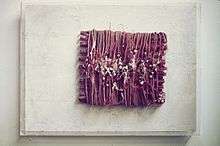
The Fragmentos Completos
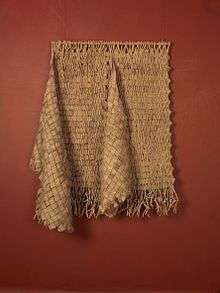
During her stay in Paris in the early 1970s, living in small spaces, Olga created a series of small pieces entitled Complete Fragments (1975). In this series the artist used gold for the first time, playing and experimenting with it. She also started to paint fibres with acrylic paint and gesso to obtain colors directly on the finished woven piece in order to dissolve the geometry imposed by the rigid structure of warp and weft. These poetic sketches were shown at the Rivolta Gallery in Lausanne, Switzerland. This technical innovation gave the artist much more freedom with the final surfaces of the works than the color-dyed fibres. It also moved her tapestries from the "crafts" to the "fine-arts" category. "Color is language common to all cultures. Color helps me to distance myself from the surface to add different meanings to the tapestry."[16] The Fragments begin a period of mostly monochromatic works culminating with the Calicanto series.
The Calicanto series
The title of the series refers to the stones used for building. The series includes the works Vestiduras de Calicanto, Paredes de Calicanto and Paisajes de calicanto and has been started in 1977. The pieces in this series are larger weavings in grass, light earth tones and sandy hues.
The new materials of the 1980s
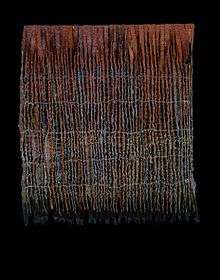
This period is characterized by enthusiastic experimentation and the introduction of new materials. During her visit to Japan for an exhibition at the National Museum of Modern Art in Kyoto, de Amaral begins to explore the use of gold and gesso inspired by Kintsugi, the Japanese art of repairing broken pottery with gold. Her exploration of gold as a material and as a color begins. She also continues to explore the possibilities of structure. Light and air filtering through woven constructions become major players. In the 1980s Olga de Amaral started the following series: Riscos, Tejidos policromos, Tierras, Tablas, Entornos, Cestas lunares, Lienzos ceremoniales, Alquimias and Montañas.

The Riscos
The title of this series alludes to cliffs. The segmented vertical bands also make allusion to the Inca quipus (khipus/talking knots) - recording devices used to collect data and keep records of time and chores. The quipus were made of colourful threads or cotton/fiber strings. The pieces in the Riscos series are mostly rectangular forms and in contrast with the vertical chained, undulated braids that hang from top to bottom, they create a sense of movement, a nearly kinetic effect. In terms of style the organic effects resemble much a living form, but the works in this series are strictly conceptual - based on the possibilities and changes in fiber structure.
The Lienzos Ceremoniales
The series Ceremonial Cloths was started in 1986 and continued through 1998. The title refers to ceremonial garments. Each piece in this series is "infused" with strong, deep color that emerges from the unified background surface. This series explores the way in which images emerge from a woven surface and the creation of a sense of depth. The superpositions of layers of thread create an aerial interplay of light that connects this series with Op Art's artistic problems.[9]
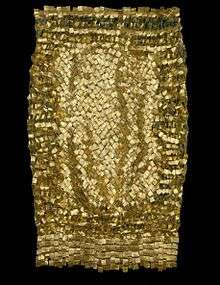
The Cestas lunares
The Moonbaskets explore the same problems as the Ceremonial Cloths - the depth and the abstract colourful images. Each piece within its unique composition studies textural and chromatic shifts on the woven surfaces (each cotton fiber is coated with gesso and paint), where the geometric images emerge - the circle of sun and moon, the arc and swirl of energies and water. The pieces from this series express feelings that arose when the artist saw the baskets made by the Yanomami, a tribe on the border between Venezuela and Brazil, also known as the Children of the Moon. This tribe creates straw baskets with circular decoration that the artist saw as a unification of the mind and the moon they worship. This inspiration can be seen in the plaiting of the Moonbaskets.
The Alquimias
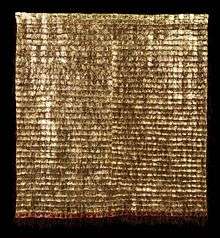
On a rapid visit to Ireland to participate in a World Craft Council conference in 1970, on her way back to Colombia, Olga passed by Lucie Rie's studio in London (she met the British ceramist at the conference). She inspired her to incorporate gold into tapestries: "That afternoon in London I noticed a break in a ceramic vase. Lucy Rie explained to me that the breakage didn't exist for her because she transformed the piece when she mended it with gold leaf, as do the Japanese when prized porcelain breaks. The concept touched me in some mysterious place of my mind". The Alchemies series, started in 1983/84 and ongoing, was the first series made entirely with gold leaf, which the artist considered, just as the alchemists did, as a symbol of knowledge. The pieces from this series are rectangular mini "canvases" made out of cotton and prepared with white-washed gesso to be covered with acrylic paint and gold/silver leaf. After experimenting with the large scale, Olga de Amaral wanted to return to a human scale. The first 13 works in the series are based on the proportion of the human figure and inspired by the ancestral culture of Peru - its objects and science, especially mathematics. Also, when the artists visited the village of Barichara in northern Colombia, the architectural landscape of that beautiful town inspired the materials and colors used in the first pieces in the series too - clay-colored linen predominantly with white, gold and blue tones. Gold has played an important role both in various Native American cultures and in the Catholic religion. The artist realised that the application of gold made the weaving appear heavy and flexible, a quality she was looking for after the early large scale weavings that had an architectural and sculptural intention. Unlike those massive constructions woven with heavy fibres such as horsehair and coarse hand-spun wool, the Alchemies are more concerned with how surfaces, textures and finishes transform the space they occupy or contain. The pieces from this series hang in a vertical, gravitational way and separated from the wall, as if they were living in their own unique space. The effect, the atmospheres they create when hung together are similar to when you enter a colonial church or the burial chambers of pre-Columbian cultures. "It has always been my desire to induce a (…) state of silence in the places where I install my pieces."[16]
Fiber as canvas. The 1990s
In the 1990s Olga de Amaral started the following series: Vesitigios, Ríos, Puertas, Pueblos, Cajas, Umbras, Bosques, Segmentos, Mementos, Imágenes perdidas, Entornos quietos, Sombras, Lunas, Paisajes heredados, Estelas and the series Prosa and Soles cuadrados.
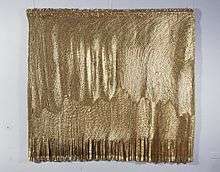
The Umbras
The title refers either to the area of the shadow of an eclipse or the dark center of a sunspot. Although the pieces in this series are rigid and immobile structures, they create vibrant, visually fluid surfaces through the use of silver or gold leaf that shade or reflect light. Together with the way the woven strands bend, the effect of each piece of this series is undefinable. Another particularity of this is series is bound to the outside and inside in the process of weaving. "In the Umbras the reverse is always the hidden layer. The back of each strand supports the color that the face reflects, and the entire back is the skeleton of the visible surface."[16]
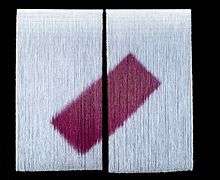
The Bosques
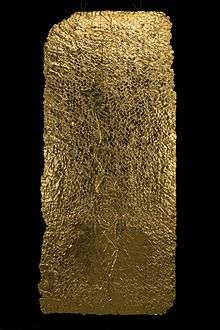
This series consists of diptychs whose rigor of surface departs radically from the abundance of the previous decade of Amaral's work. Bridging the spaces is a square or a rectangle, in some cases with a shift in color but not in form. The geometric forms seem to be in movement from one plane to another.
The Estelas
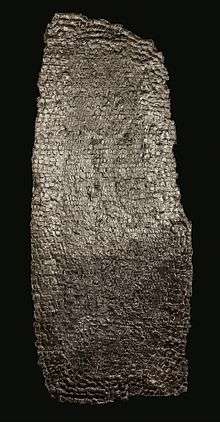
In the series of the Estelas started in 1996, just like with the Umbras, the inside and outside again came to the artist's consideration. The title refers to the Spanish word estrella that stands for star and "es tela" that stands for "is [made of] fabric". Olga de Amaral has always considered the back of her pieces as a side to experiment, but in this series she decided to work on both sides as equal. The front of the Stelae is luminous gold and the back dark silver, still maintaining the vestiges of the original experimental function of this side. "I think of them as stones full of space, each one a presence full of secrets. Many together, like mounds of stones or rocks, point to an answer, an unknown order, a hidden history". These pieces gained a three-dimensional character as they are always exhibited suspended from the ceiling at different elevations and angles and in a group, with each side (golden or silver) facing in one direction. The effect of these pieces is contradictory - being both solid surfaces, bringing the solidity of the ruins of past civilisations, and at the same time floating and immutable. The Stelae were shown at Galería Diners in Bogotá and in museums in the United States and Europe in 1999.
2000-2010 and recent work
After the year 2000 Olga de Amaral started the following series: Ombríos, Mapas, Escritos, Aguas/Aquas, Glyphs, Alforjas, Espejos, Piedras, Stratas, Nudos, Memorias, Policromos, Entre ríos, Pozos azules, the series Sol rojo, Árboles, Brumas, Dos mitades, Moyas, Nébulas, Fósiles, Núcleos, Rocas, Minutas, Improntas and Lienzos.
Art market
The prices at auctions for Olga de Amaral's art, and in consequence the gallery price records, have risen to four times what they were in just ten years. This change in interest and the collector's "desire" for her art as possessing a long-term monetary value is only recent and pretty abrupt, with astonishingly high sales in the past few years.[19] The process of creation, making all her pieces by hand and very carefully, causes that there are not that many artworks offered for sale. Until recently auction results for Olga de Amaral were extremely sparse (and completely non-existent in some years). The works that were sold at auctions were mostly from the 1980s, 1990s, and 2000s and this situated the artist as contemporary and not modern, as it has been the case with most of the Latin American auction market. Also, the genre of Latin American abstraction and textile-based art practices gained worldwide attention only recently.[20]
Collections
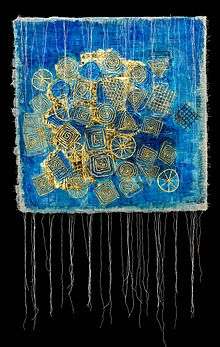
Olga de Amaral's art is collected by major museums, corporations and private collectors. Her work is represented in the collections of over thirty museums, foundations, galleries and art schools. In Europe and Asia in the Musée d’Art Moderne de la Ville in Paris and Musée Jean Lurçat et de la Tapisserie Contemporaine in Angers in France, in the Toms Pauli Foundation in Lausanne and the Museum Bellerive in Zurich in Switzerland, in the Museum of Modern Art in Kioto in Japan. In the USA in the Art Institute of Chicago, Cleveland Museum of Art, Denver Art Museum, Museum of Fine Arts in Houston, Fine Arts Museums of San Francisco, in the Metropolitan Museum of Art, Museum of Modern Art and the Museum of Arts and Design in New York, the Renwick Gallery of the Smithsonian American Art Museum in Washington D.C., in the Rhode Island School of Design, in the Chrysler Museum of Art in Norfolk, in the Cranbrook Academy of Art Museum in Michigan, in the Bass Museum in Miami and in the Palm Springs Art Museum, among others. In Colombia Olga de Amaral's work can be found in the permanent collections of the Museo del Banco de la República, Museo de Arte Moderno and Museo Nacional of Colombia in Bogotá and in La Tertulia Museum in Cali, Colombia. Olga de Amaral's work is also part of numerous corporate collections worldwide, including Citibank in New York City, Le Méridien Hotel that is part of the Embarcadero Center in San Francisco, the Omaha Public Library, Nuveen Investments in Chicago, Inter-American Development Bank in Washington D.C., Macquarie University in Sidney in Australia, Hotel Nicolás de Obando in Santo Domingo in the Dominican Republic. In Colombia the artist's works are part of the permanent collections of Clínica Santa Fe de Bogotá, Club El Nogal, Federación Nacional de Cafeteros en Bogotá and in Coltejer in Medellín and the Hotel Santa Clara in Cartagena.
Awards and recognitions
- 1968–72 Colombian representative for the World Crafts Council in Lima, Perú.
- 1970–74 Latin American representative for the World Crafts Council.
- 1971 First Prize in the XXII Salón Nacional de Artistas in Bogotá, Colombia
- 1972 First Prize in the Tercera Bienal de Artes de Coltejer in Medellín, Colombia.
- 1973 Guggenheim Fellowship, New York, USA.[21]
- 1989 Honorary Chair in the Art Department at the University of California at Los Angeles, USA.
- 1989 Arts Council member, the University of California at Los Angeles, USA.
- 2005 Visionary Artist recognition by the Museum of Arts and Design in New York, USA.
- 2006 Olga de Amaral Award established at the 4th International Biennial of Textile Art, San Jose, Costa Rica.
- 2008 Honorary Co-Chair for the benefit of the Multicultural Audience Development Initiative at the Metropolitan Museum of Art in New York, USA.
- 2009 Olga de Amaral Award given to Dr Ruth Corcuera at 5th International Biennial of Textile Art, organized by the World Textile Art Organization (WTA) in Buenos Aires, Argentina.
- 2010 Member of the Academia Nacional de Bellas Artes in Buenos Aires, Argentina.[22]
- 2011 Honoree of the Multicultural Benefit Gala at the Metropolitan Museum of Art, New York, USA.[23]
Select solo exhibitions
- 1958 Sociedad Colombiana de Arquitectos, Bogotá, Colombia.
- 1961 Galería El Callejón, Bogotá, Colombia.
- 1966 Universidad de Carabobo, Venezuela.
- 1966 Museo de Bellas Artes, Caracas, Venezuela.
- 1966 Galería T. A. B., Bogotá, Colombia.
- 1967 Olga de Amaral: Exhibition of Contemporary Weaving, Skidmore Gallery, Saratoga Springs, New York, NY, USA, November 13–22.
- 1967 Hall’s, Kansas City, Missouri.
- 1967 Weavings by Olga de Amaral, Jack Lenor Larsen Showroom, New York, NY, USA, February 14 – March 31.
- 1970 Muros Tejidos: Olga de Amaral, Biblioteca Luis Angel Arango, Banco de la Republica, Bogota, Colombia, January.
- 1970–1971 Woven Walls by Olga de Amaral, Museum of Contemporary Crafts, New York, NY, USA, September 30, 1970 – January 3, 1971.[24]
- 1972 Museo de Arte Moderno, Bogotá, Colombia.
- 1973 Andre Emmerich Gallery, New York, NY, USA.
- 1973 Olga de Amaral: Marañas Tejidas, Galerie La Demeure, Paris, France, May 15 – June 8.
- 1974 Olga de Amaral: Woven Sculpture, André Emmerich Gallery, New York, NY, USA, December 1 – January 5.
- 1975 Olga de Amaral: Tapisseries, Galerie Rivolta, Lausanne, Switzerland.
- 1975 Olga de Amaral, Melville Hall, Australian National University, Acton, Australia, November 27 – December 10.
- 1976 Fragmentos Completos, Serie Incompleta, Galería Belarca, Bogotá, Colombia, December 7–24.
- 1977 Olga de Amaral, La Galería, Quito, Ecuador.
- 1979 Olga de Amaral, Instituto Panameño de Arte, Panama City, June.
- 1980 Olga de Amaral, Galería Témpora, Bogotá, Colombia, November 13 – December 20.
- 1983 Olga de Amaral: Woven Matter, Modern Masters Tapestries, New York, NY, USA, April 28 – May 24.
- 1984 Olga de Amaral, The Allrich Gallery, San Francisco, CA, USA, May 17 – June 23.
- 1985 Olga de Amaral, The Allrich Gallery, San Francisco, CA, USA, November 5–28.
- 1986 Colombia nelle Corderie dell’Arsenale, 42nd Venice Biennale, Venice, Italy.
- 1987 Olga de Amaral: Recent Work, The Allrich Gallery, San Francisco, CA, USA, November 5–28.
- 1987 Olga de Amaral, Bellas Artes Gallery, Santa Fe, NM, USA, July to August.
- 1988 New Art Forms Exposition: 20th Century Decorative and Applied Arts, Navy Pier, Chicago, IL, USA.
- 1989 Olga de Amaral: Tapestries from the Moonbasket and Montaña Series, essay by Jack Lenor Larsen, The Allrich Gallery, San Francisco, CA, USA, November 9 – January 6.
- 1990 Olga de Amaral: New Works, Bellas Artes Gallery, Santa Fe, New Mexico, USA, travelling to New York, NY, October 31 – December 15.
- 1992 Olga de Amaral: Lost Images, Inherited Landscapes, Johnson County Community College Gallery of Art, Overland Park, Kansas, USA, May 31 – July 10.
- 1992 Olga de Amaral: Lost Images, Bellas Artes Gallery, Santa Fe, New Mexico, USA, August 8 – September 22.
- 1993 Olga de Amaral: Cuatro tiempos, Bogotá Museum of Modern Art, Bogotá, Colombia, November 1993 – February 1994.[25]
- 1993 Lost Images, Inherited Landscapes, The Allrich Gallery, San Francisco, CA, USA, March 25 – May 8.
- 1993 Olga de Amaral: El arte de tejer, Salón Cultural Avianca, Barranquilla, Colombia, October.
- 1994 Olga de Amaral, Galería Pérez McCollum, Guayaquil, Ecuador, June 16 – July 5.
- 1994 Olga de Amaral: Sol y Luna, Bellas Artes Gallery, Santa Fe, New Mexico, USA, July 14 – August 22.
- 1996 Olga de Amaral: Estelas, Galería Diners, Bogotá, Colombia, August 28 – November 2.
- 1996 Olga de Amaral: Textiles, Peter Joseph Gallery, New York, NY, USA, April 25 – June 7.
- 1996 Nine Stelae and Other Landscapes, curated by Jacquelin Pilar, Fresno Art Museum, Fresno, CA, USA, September 10 – November 10.
- 1997 Olga de Amaral: Monoliths and Other Landscapes, Cleveland Institute of Art, Cleveland, Ohio, USA, August 22 – October 5.
- 1997 Olga de Amaral: Umbra, Bellas Artes Gallery, Santa Fe, New Mexico, USA, August 7 – September 20.
- 1997 Olga de Amaral: Rétrospective 1965-1996, Musèe de la Tapisserie Contemporaine, Angers, France, June 25 – November 9.
- 1997 Olga de Amaral: Seven Stelae, Federal Reserve Board, Washington D.C., USA.
- 1997 Olga de Amaral: Estelas y paisajes, Museo de Arte de Pereira, Pereira, Colombia, November 22 – January 10.
- 1999 Olga de Amaral: Estelas, Bosques, Umbras, Galería Diners, Bogotá, Colombia, February.
- 1999 Olga de Amaral: Forests, Stelae, Umbras, Hillside Terrace, Tokyo, Japan, May.
- 1999 Olga de Amaral: Woven Gold, Albuquerque Museum of Art and History, Albuquerque, New Mexico, USA, January 31 – April 25.[26]
- 2000 Pasos, Bellas Artes Gallery, Santa Fe, New Mexico, USA, August 10 – September 30.
- 2001 Olga de Amaral: El Manto de la Memoria, Club el Nogal, Bogota, Colombia, April 3 – May 5.
- 2002 Tiempos y tierra, Museo de la Nación, Lima, Perú, July–August.
- 2003 Glyphs, Bellas Artes Gallery, Santa Fe, New Mexico, USA, July 30 – August 30.
- 2004 Threaded Words, Embassy of Colombia to the United States, Washington D.C., USA, May.
- 2005 Olga de Amaral: Resonancias, Centro Cultural de Belém, Lisbon, Portugal, September 14 – October 14.
- 2007 Strata, Centro Cultural Casa de Vacas, Madrid, Spain.
- 2008 The Golden Fleece, Eretz Israel Museum, Tel Aviv, Israel, February 1 – May 24.[27]
- 2008 Olga de Amaral: Strata, Galería La Cometa, Bogotá, Colombia, October–November.
- 2009 Nudos, Bellas Artes Gallery, Santa Fe, New Mexico, USA, July 31 – August 29.
- 2010 Entre Pueblos & Oeuvres récentes, installation by Juan Montoya, Galerie Jean-Jacques Dutko, Paris, France.
- 2011 VII Pueblos & VII Polícromos, Bellas Artes Gallery, Santa Fe, New Mexico, USA, August 5 – September 10.
- 2012 Olga de Amaral & Do Konig Vassilakis, Galerie Agnès Monplaisir, Paris, France.
- 2012 Olga de Amaral: Places, Nohra Haime Gallery, New York, New York, USA, September 13 – October 31.
- 2012 Boundaries, Latin American Masters Gallery, Los Angeles, CA, USA, February 4 – April 14.
- 2014 Olga de Amaral: El Dorado Thread, Galerie Agnès Monplaisir, Paris, France, September 12 – October 25.
- 2014 Olga de Amaral, SP-Arte (São Paulo International Art Fair), São Paulo, Brasil, April 9–12.
- 2015 Olga de Amaral: Color Sombra, Galeria La Cometa, Bogota, Colombia, February 19 – April 2.
- 2016 Estados presentes (con Jim Amaral), CasaCano, Bogotá, Colombia, October 20 – December 3.
- 2016 Olga de Amaral: 30 años con Bellas Artes, Bellas Artes, Santa Fe, USA, June 16 – September 10.[28]
- 2016–2017 CORTEX DE NOTRE TERRE, Galerie Agnes Monplaisir, Paris, France, November 18, 2016 – January 14, 2017.
Select group exhibitions
- 1967 3rd International Biennial of Tapestry, Lausanne, Switzerland.
- 1967 Textiles Colombianos, Colombian Center, New York, NY.
- 1968 The Intersection of the Line, California State University at Long Beach, Long Beach, CA, USA.
- 1968 Ceramics by Mutsuo Yanagihara, Weavings by Olga de Amaral, Museum West, San Francisco, CA, USA, May 17 – June 23.
- 1969 The Egg and the Eye Gallery, Los Angeles, CA, USA.
- 1969 Detroit Institute of Arts, Detroit, Michigan, USA.
- 1969 Wall Hangings, Museum of Modern Art, New York, NY, USA.[14]
- 1969 4th International Biennial of Tapestry, Lausanne, Switzerland.
- 1970 Olga de Amaral, Else Bechteley, Sheila Hicks, Galería Buchholz, Munich, Germany, April.
- 1971 5th International Biennial of Tapestry, Musée cantonal des beaux-arts, Palais de Rumine, Lausanne, Switzerland, June 18 – October 3.
- 1971 Zacheta Gallery, Warsaw, Poland.
- 1971 Textile Constructions, Ruth Kaufmann Gallery, New York, NY, USA.
- 1971 Deliberate Entanglements (travelling exhibition), University of California at Los Angeles Art Gallery, Los Angeles, CA, USA; University of Oregon, Portland, Oregon; University of Utah, Salt Lake City, Utah; and the Palace of the Legion of Honor, San Francisco, CA, USA.
- 1972 Tercera Bienal de Arte Coltejer, Medellín, Colombia.
- 1973 Triennale di Milano, Milan, Italia.
- 1973 Museo de Arte Moderno, Bogotá, Colombia.
- 1973 Fibre work, The Emily Lowe Gallery, Hofstra University, Hempstead, New York, USA, April 29 – May 27.
- 1974 XXV Salón Nacional de Artes Visuales, Govett Brewster Art Gallery, New Plymouth, New Zealand.
- 1975 7th International Biennial of Tapestry, Lausanne, Switzerland.
- 1975 Arte Colombiano a Través de los Siglos, Musèe Petit Palais, Paris, France.
- 1975 Superficies, Grand Palais, Paris, France.
- 1976 Musèe Ingres, Montauban, France.
- 1977 8th International Biennial of Tapestry, Lausanne, Switzerland.
- 1977 National Museum of Modern Art, Kyoto, Japan.
- 1977 The Cleveland Museum of Fine Art, Cleveland, Ohio.
- 1980 Garces Velasquez Galeria, Le Grand Palais, F.I.A.C., Paris, France.
- 1981 Olga de Amaral, Grau Garriga, Tapta, Varbanov, Musèe d’Art Moderne de la Ville de Paris, France, October.
- 1982 FIAC Madrid, Spain.
- 1983 3 x 5: Works in Fiber, Modern Master Tapestries, Inc., December 1 – January 4.
- 1983 Musèe des Ecoles des Beaux Arts, Paris, France.
- 1985 Threads: Small Scale Textiles, Palo Alto Cultural Center, Palo Alto, CA, USA.
- 1985 Fiberworks, Invitational Exhibition of Contemporary Fiberworks, University of Texas, El Paso, Texas, USA.
- 1985 Olga de Amaral and Valentina Dubasky, Gloria Luria Gallery, Bay Harbor, FL, USA, April 3–27.
- 1986 Contemporary Crafts: A Concept in Flux The Society for Art in Crafts, Philadelphia, Pennsylvania, USA.
- 1987 13th International Tapestry Biennale, Musée Cantonal des Beaux- Arts, Lausanne, Switzerland.
- 1987 Interlacing: The Elemental Fabric, curated by Jack Larsen, The Pavillon, Dallas, TX, USA; travelled to The Textile Museum, Washington D.C.
- 1987 Six Decades of American Fiber, curated by Jack Larsen, Oregon Historical Museum, Portland, Oregon, USA.
- 1988 New Traditions, Nordenfeldske Kunstindustrimuseum, Trondheim, Norway.
- 1989 4th Annual Exhibition curated by Jack Lenor Larsen, Bellas Artes Gallery, Santa Fe, NM, USA, June–August.
- 1989 La Mujer Artista, Galeria Alfred Wild, Bogota, Colombia, October.
- 1990 High Fiber, Gallery Camino Real, Boca Raton, FL, USA, November 1–24.
- 1990 Olga de Amaral and Robert Turner, Bellas Artes Gallery, Santa Fe, NM, June 30 – July 21.
- 1990 Arte Colombiano: La Presencia Femenina, U.S. Embassy in Bogota, Colombia, October.
- 1992 15th International Lausanne Biennial Contemporary Textile Art, Musée cantonal des beaux-arts, Palais de Rumine, Lausanne, Switzerland, from April 4 – June 28; travelled to Textielmuseum, Tilburg, Netherlands (October 3, 1992 – January 17, 1993), and at the Nordjyllands Kunstmuseum, Aalborg, Denmark (March 26 – May 10, 1993).
- 1992 Modern Design: 1890-1990 (with exhibition catalog), The Metropolitan Museum of Art, New York, NY, USA.
- 1994 The Gold Show, Palo Alto Cultural Center, Palo Alto, CA, USA.
- 1994 Focus on Fiber Art: Selection from the Growing 20th Century Collection, The Art Institute of Chicago, Chicago, IL, USA.
- 1995 Latin American Women Artists 1915-1995 (with exhibition catalog), Milwaukee Art Museum, Milwaukee, Wisconsin, USA.
- 1995 Phoenix Art Museum, Phoenix, Arizona, USA.
- 1995 Denver Art Museum, Denver, Colorado, USA.
- 1995 National Museum of Women in the Arts, Washington, D.C., USA.
- 1999 The Saxe Collection Donation, de Young Museum, San Francisco, California.
- 2001 Barro de América, Museo Nacional de Bellas Artes, Caracas, Venezuela.
- 2001 Mes de Colombia, Museo Nacional de Bellas Artes, Buenos Aires, Argentina, July.
- 2001 Beauty Without Regret, curated by Robert Kushner, Bellas Artes Gallery, Santa Fe, New Mexico, June 28 – August 4.
- 2002 SOFA Chicago, Chicago, IL, USA.
- 2003 Gary Nader Gallery, Miami, Florida, USA.
- 2006 Tradición y vanguardia en el arte colombiano, Salon Nacional de Artistas, Museo Nacional de Colombia, Bogota, Colombia.
- 2006–07 One of a Kind: The Studio Craft Movement, Metropolitan Museum of Art, New York, NY.[29]
- 2008 FIA Caracas, Galería La Cometa, Caracas, Venezuela.
- 2008 Feria Internacional de Arte de Bogotá, ArtBO, Galería La Cometa, Bogotá, Colombia.
- 2008 Museum of Art & Design, New York, NY.
- 2009 Plusultra Oltre il barocco: Arte latino-americana a confronto, curated by Giorgio Antei, Santa Giulia Museo della Città, Brescia, Italy, December 4 – July 27.
- 2009 Estructuras y Esculturas: Jim y Olga de Amaral, Galería Club El Nogal, Bogotá, Colombia.
- 2009 Huellas: Olga de Amaral, Presencia: Jim Amaral, Corpbanca, Caracas, Venezuela, May–June.
- 2012 Œuvres textiles & Sculptures, Galerie Agnès Monplaisir, Paris, France.
- 2012 Sourcing the Museum, Textile Museum, Washington D.C., USA, March 23 – August 19.
- 2014–15 Fiber: Sculpture 1960–present, Institute of Contemporary Art, Boston, October 1, 2014 – January 4, 2015; travelled to Wexner Center for the Arts, Columbus, Ohio (January 30 – April 5, 2015) and Des Moines Art Center, Iowa (May 8 – August 2, 2015).
- 2014 Artevida, Casa França Brasil, Rio de Janeiro, Brazil, June 28 – September 21.
- 2014 Chic Matière(s). Galerie Agnès Monplaisir, Paris, France.
- 2014 Paper Trail, Latin American Masters, Los Angeles, CA, USA, May–July.
- 2014 Decorum, Power Art Station, Shanghai, China.
- 2014-15 Waterweavers: The River in Contemporary Colombian Visual and Material Culture, curated by Jose Roca, Bard Graduate Center, New York, NY, April–August 2014; travelled to Centro Conde Duque, Madrid.
- 2014–15 Gold, curated by Jose Carlos Diaz, Bass Museum, Miami Beach, Florida, USA, August 8, 2014 – February 15, 2015.
- 2015 Embracing Space & Color: Art On & Off the Wall, Vero Beach Museum, Miami Beach, Florida, USA, February 20 – June 7.
- 2015–16 Pathmakers: Women in Art, Craft and Design, Midcentury and Today, Museum of Arts and Design, New York, NY, USA, April 28 – September 27; travelled to the National Museum of Women in the Arts, Washington DC (October 30 – February 28, 2016).
- 2016 Unorthodox, Jewish Museum (Manhattan), NYC, USA, November 6 – March 27.[30]
- 2017 De la línea al espacio: Jim Amaral, Olga de Amaral, y Ricardo Cárdenas, Bogotá Museum of Modern Art.[31]
- 2019 Beyond the Loom: Fiber as Sculpture / Subversive Threads, as featured in the Museum of Fine Arts Boston's Women Take the Floor exhibition, "which challenges the dominant history of 20th-century American art by focusing on the overlooked and underrepresented work and stories of women artists."[32] September 13, 2019 – May 3, 2021.
References
- Phaidon Editors (2019). Great women artists. Phaidon Press. p. 31. ISBN 0714878774.
- Parrish, Sarah (2014). Porter, Jenelle (ed.). Fiber: Sculpture 1960-present. Institute of Contemporary Art/Boston and Delmonico Books Prestel. p. 182. ISBN 978-3-7913-5382-1.
- "About Olga de Amaral", Retrieved online 14 October 2018.
- "Olga de Amaral" Smith Davidson Gallery, Retrieved online 14 October 2018.
- "Jim and Olga de Amaral: Lives Reflected in Art.", City Paper, Retrieved 28 July 2018.
- de Amaral, Olga (2013). Olga de Amaral. The Mantle of Memory. Somogy Art Publishers/Galerie Agnes Monplaisir/Amaral Editores. ISBN 978-2-7572-0756-7.
- Rubio, Lorraine. "Artnet Asks" Textile Artist Olga de Amaral", artnet, Retrieved 28 July 2018.
- Hoffmann, Jens, ed. (2015). Unorthodox, exh. cat. The Jewish Museum, New York/Yale University Press. p. 36. ISBN 978-0-300-21934-0.
- Leenhardt, Jacques (2013). The Art of Tapestry of the Weaving of Meaning. Olga de Amaral. The Mantle of Memory. Somogy Art Publishers /Galerie Agnes Monplaisir/Amaral Editores. pp. 163–190. ISBN 978-2-7572-0756-7.
- Drutt, Matthew (October 2013). "Modern Painters". Colombian Gold. Olga de Amaral spins ore into art.
- Roca, José; Martín, Alejandro (2014). exh. cat. Waterweavers. A Chronicle of Rivers. New York, USA: Bard Graduate Center. p. 312. ISBN 978-0-9824680-1-2.
- Moyer, Twylene (2013). Illuminating Vision: Materials and Meaning in the Work of Olga de Amaral. Olga de Amaral. The Mantle of Memory. Simogy Editions d'Art/Galerie Agnes Monplaisir/Amaral Diseno. pp. 145–156. ISBN 978-2-7572-0756-7.
- Osorio, Amparo (2015). Moving images. Olga de Amaral. Color Sombra. Bogotá, Colombia: Galería La Cometa. pp. 5–7.
- "Olga de Amaral in MoMA Exhibitions", Museum of Modern Art, Retrieved 17 November 2018.
- Porter, Jenelle (2014). "About 10 Years: From the New Tapestry to Fiber Art". In Porter, Jenelle (ed.). Fiber: Sculpture 1960-present. Institute of Contemporary Art/Boston and Delmonico Books Prestel. pp. 171–175. ISBN 978-3-7913-5382-1.
- de Amaral, Olga (2003). The House of My Imagination. Lecture by Olga de Amaral at the Metropolitan Museum of Art. Bogotá, Colombia: Zona Ltda.
- Pau-Llosa, Ricardo (2013). The Eye's Music or the Emergence of the Thaumaturgical Object: An approach to the Art of Olga de Amaral. Olga de Amaral: The Mantle of Memory. Smoggy Editions d'Art/Galerie Agnes Monplaisir/Amaral Editores. pp. 87–142. ISBN 978-2-7572-0756-7.
- Smith, T’ai (2014). "Tapestries in Space: An Alternative History of Site-Specificity". In Porter, Jenelle (ed.). Fiber: Sculpture 1960-present. Institute of Contemporary Art/Boston and Delmonico Books Prestel. p. 153. ISBN 978-3-7913-5382-1.
- "Biography of Olga de Amaral - BLOUIN ARTINFO, The Premier Global Online Destination for Art and Culture | BLOUIN ARTINFO". www.blouinartinfo.com. Retrieved 2016-06-15.
- "Prices rising for Olga de Amaral's artworks--artnet News". artnet News. 2015-06-18. Retrieved 2016-06-15.
- "John Simon Guggenheim Foundation Fellowship - Olga de Amaral", Guggenheim Foundation Online website, Sourced July 29, 2018.
- "Amada, Olga de - ANBA", Academia Nacional de Bellas Artes, Retrieved 30 May 2020.
- "Metropolitan Museum's September 26 Multicultural Benefit to Celebrate "An Evening of Many Cultures", Metropolitan Museum of Art, Retrieved online 14 October 2018.
- "Woven Walls by Olga de Amaral", American Craft Council, Retrieved online 14 October 2018.
- "Cuatro Tiempos", Museum of Fine Arts Houston, Retrieved online 14 October 2018.
- "Past Exhibitions at the Albuquerque Museum", City of Albuquerque, Retrieved online 14 October 2018.
- "The Golden Fleece", Eretz Museum, Retrieved online 14 October 2018.
- "30 años con Bellas Artes", Bellas Artes, Retrieved online 14 October 2018.
- "One of a Kind: The Studio Craft Movement", Metropolitan Museum of Art, Retrieved 17 November 2018.
- "Unorthodox", Jewish Museum, Retrieved 17 October 2018.
- "De la línea al espacio", Museo de Arte Moderno Bogotá, Retrieved 17 November 2018.
- "Women Take the Floor". Museum of Fine Arts Boston. Museum of Fine Arts Boston. Retrieved 2 March 2020.
External links
| Wikimedia Commons has media related to Olga de Amaral. |
- Official website
- Video, The House of My Imagination
- Video from the exhibition at Latin American Masters in 2012.
- Video from the exhibition in London in 2013.
- Video from the exhibition "Color Sombra" in Galería La Cometa in Bogotá, Colombia.
- Olga de Amaral's work at Galerie Agnes Monplaisir in Paris.
- Olga de Amaral's work at Bellas Artes Gallery in Santa Fe, New Mexico, USA.
- Olga de Amaral's work at Nohra Haime Gallery in NYC.
- Olga de Amaral on artsy.net.
- "Form and Fiber: Olga de Amaral's Textiles Weave Craft with Abstraction", 2016 article on Phillips.com.